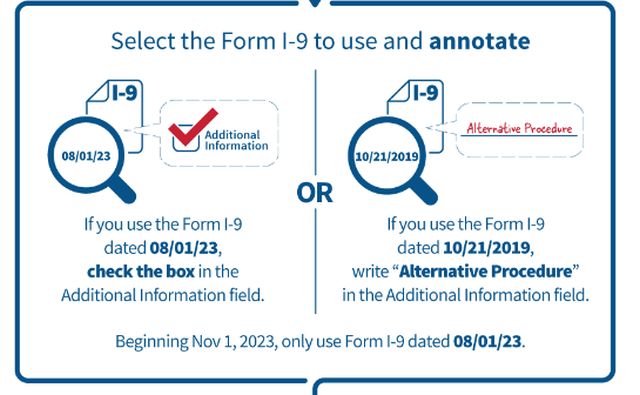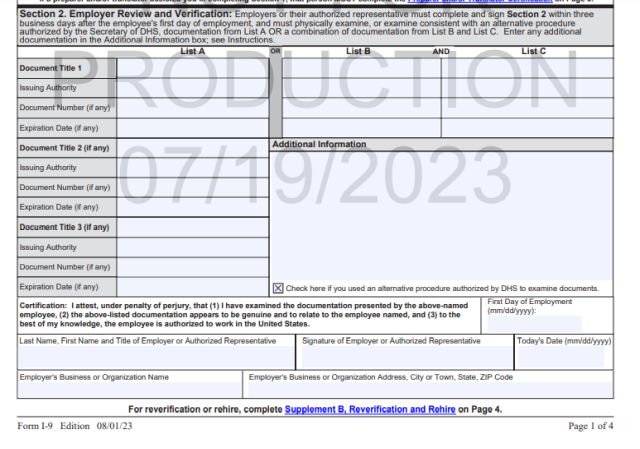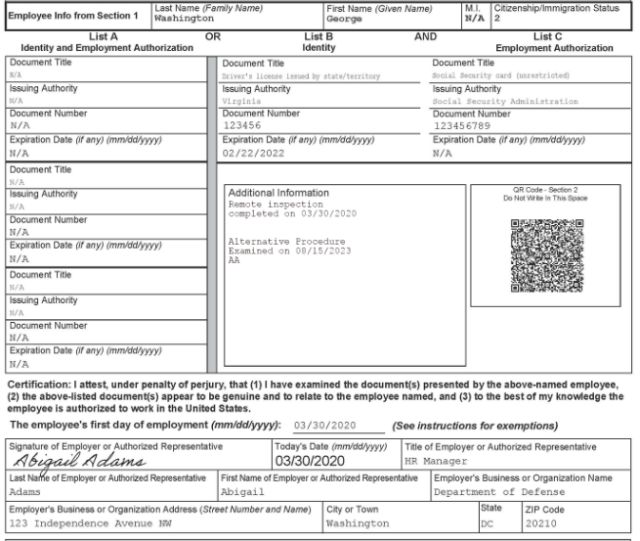- in European Union
- within Antitrust/Competition Law topic(s)
- with readers working within the Healthcare industries
On August 1, all U.S. employers will have the option to use the new "one-page" Form I-9 (edition date 08/01/2023). The new August 2023 Form I-9 and Instructions are only available in draft form before August 1, 2023 via the Federal Register posting. Employers may use the current version of Form I-9 (edition date 10/21/2019) through October 31, 2023. The cosmic shift, however, in Form I-9 completion is the possibility of a permanent virtual/remote verification of the identity and work verification documents presented by an employee. Certain qualified employers enrolled in E-Verify will have the option on August 1 to start using a process eliminating, if desired, all in person verification, unless the employee demands in-person review of their Form I-9 documents.
Note: Starting November 1, 2023, all employers must use the new Form I-9.
What are the main changes in the new Form I-9?
- They may have scrunched the current two page Form I-9 to one page, but there are now four pages to the Form I-9. The List of Acceptable Documents (LOAD) is on a separate page with links to some (not all-inclusive) examples of List C employment authorization documents issued by the Department of Homeland Security (DHS) at uscis.gov/i-9central. There is also a separate Supplement A page for the Preparer/Translator part of Section 1 as well as a Supplement B page for Reverification and Rehiring (formerly referred to Section 3 of the Form I-9).
- It is designed to be a fillable form on tablets and mobile devices.
- There is now a checkbox for use, when applicable, by employers to indicate when they have examined Form I-9 documents remotely under a DHS optional authorized alternative procedure versus the normal required physical inspection.
Note: On August 1, 2023, certain qualified E-Verify Employers may use a remote inspection process to view Form I-9 documents for New Hires.
What Employers may choose to use the new Optional Alternative (OA) virtual/remote inspection option for New Hires on or after August 1, 2023 and at what locations?
- Employers enrolled in E-Verify.
- E-Verify hiring sites enrolled in E-Verify, in accordance with the E-Verify Memorandum of Understanding (MOU).
- Employers in good standing in E-Verify pursuant to the terms of the MOU anytime use of OA inspection is used.
- New E-Verify employers and any users who manage and create E-Verify cases must complete a free E-Verify tutorial accessible on-line as part of the E-Verify enrollment process to any users who manage and create E-Verify cases.
What if an employee demands that the employer use the normal physical inspection process of their documents presented for Form I-9 completion?
The employer must comply with the request.
May a qualified employer offer the alternative procedure to only some employees?
- If an employer chooses to use the OA process, it must apply the alternative procedure to either: (1) all employees at the enrolled hiring site; or (2) all remote employees at the enrolled hiring site. A qualified employer may choose to use the OA process for remote hires only but continue to apply physical examination procedures to all employees who work onsite or in a hybrid capacity,if the employer does not adopt such a practice for a discriminatory purpose.
What must a Qualified Employer (or an authorized representative acting on the employer's behalf, such as a third-party vendor) do to comply with the new OA virtual/remote inspection process for New Hires?
- Examine copies (front and back, if the document is two-sided) of Form I–9 documents or an acceptable receipt1 to ensure that the documentation presented reasonably appears to be genuine;
- Conduct a live video interaction with the individual presenting the document(s) to ensure that the documentation reasonably appears to be genuine and related to the individual. The employee must first transmit a copy of the document(s) to the employer (per Step 1 above) and then present the same document(s) during the live video interaction;
- Indicate on Form I–9, by completing the corresponding box, that an alternative procedure was used to examine documentation to complete Section 2 or for reverification, as applicable;2
- Retain, consistent with applicable regulations,3 a clear and legible copy of the documentation (front and back if the documentation is two-sided);4
- Timely create a case in E-Verify (within three business days of an employee's date of employment); and
- In the event of a Form I–9 audit or investigation by a relevant federal government official, make available the clear and legible copies of the identity and employment authorization documentation presented by the employee for document examination in connection with the employment eligibility verification process.
AND...
Add the phrase, ''alternative procedure'', with the date of examination (i.e., the date the employer performed a live video interaction as required under the alternative procedure) to the Section 2 "Additional Information" field on the Form I–9 or in Section 3, as appropriate.5

Example of Section 2 of new Form I-9 with box checked for use of OA procedure for remote inspection.

COVID-19 Flexibilities and the New OA Process
As I noted in an earlier blog, employers using the prior COVID-19 Flexibilities announced by DHS must reinspect the documents presented remotely for Form I-9 completion in person by August 30, 2023. May this August 1 OA option be used for the required reinspection? YES
What Employers qualify to use the OA process to inspect documents remotely again to update Forms I-9 completed under the temporary COVID-19 Form I-9 policies?
Qualified Employers are those who:
- Are enrolled in E-Verify in good standing6;
- Were enrolled in E-Verify at the time that they performed a remote examination of an employee's Form I-9 documentation (for Section 2 or for reverification) under the COVID-19 flexibilities;
- Created an E-Verify case for that employee (unless the documentation was reviewed solely for reverification); and
- Performed the remote inspection between March 20, 2020 and July 31, 2023.
An employer meeting all of these requirements is eligible to conduct its post-COVID Form I-9 update using the OA virtual review process. Such employers should not create a new case in E-Verify as a part of this OA procedure.
Using the OA process for reinspection of documents remotely before the August 30, 2023 deadline requires the same "alternative procedure" reference in the Additional Information Section of the Form I-9. Of course, the Additional Information Section of the Form I-9 should already include a reference to the use of remote inspection during the above-referenced COVID-19 Flexibilities period. Below is an example from DHS regarding an annotation for a reinspected Form I-9 using the OA process.

What has DHS indicated concerning the use of enforcement resources by Immigration and Customs Enforcement (ICE) regarding the reinspection of documents presented for Form I-9 completion, which were remotely viewed by employers or their representatives/designees during the announced policy of COVID-19 flexibilities?
On July 21, 2023, DHS posted the following statement:
If an employer is otherwise compliant with the law and regulation – and had followed the COVID-19 flexibility guidance – U.S. Immigration and Customs Enforcement (ICE) will generally not focus its limited enforcement resources on Form I-9 verification violations for failing to complete physical document examination by August 30, 2023, particularly where the employer can show that it has taken timely steps to complete physical document examination within a reasonable period of time.
Of course, physical inspection requirements may be met as of August 1, 2023 by qualified employers using the optional OA process described in this article.
We expect ongoing further guidance regarding this process from DHS. In the meantime, certain E-Verify employers now have at least a rational option to choose in order to comply with Form I-9 in our evolving remote workforce world. This option should be expected to increase E-Verify enrollment.
Footnotes
1. Occasionally, employees may present a ''receipt'' in place of a List A, B, or C document. An acceptable receipt is valid for a specified period of time so an employer can complete the Form I–9. Employers cannot accept receipts if employment will last less than three days. An acceptable receipt may be a receipt for the application to replace a List A, B, or C document that was lost, stolen, or damaged; the arrival portion of Form I–94 (Arrival/ Departure Record) with a temporary Form I–551 stamp and a photograph of the individual; the departure portion of Form I–94 (Arrival/Departure Record) with an unexpired refugee admission stamp; or an admission code of ''RE.'' See USCIS, Handbook for Employers, M–274, available at https://www.uscis.gov/i-9-central/form-i-9- resources/handbook-for-employers-m-274/40- completing-section-2-of-form-i-9/43-acceptable receipts.
2. The new edition of the Form I–9 is effective on August 1, 2023. Employers may continue to use the 10/21/2019 edition of the Form I–9 from August 1, 2023 until the end of October 31, 2023. As described elsewhere in this rule and accompanying notice, if during this grace period an employer uses the 10/21/2019 edition of the Form I–9 for the alternative procedure, the employer must indicate its use of the alternative procedure by writing ''alternative procedure'' in the Additional Information field in Section 2. No later than November 1, 2023, employers must begin using the August 1, 2023 edition of the Form I–9. When using the August 1, 2023, edition of the Form I–9, an employer must indicate their use of the alternative procedure by completing the corresponding box in Section 2 or in the section corresponding to reverification (which is Supplement B in the August 1, 2023 edition of Form I–9), as appropriate.
3. See 8 CFR §§274a.2 (b)(3), (e), (f), and (g).
4. Employers must retain and store the Form I–9 for three years after the date of hire, or for one year after employment ends, whichever is later. See 8 U.S.C. §1324a(b)(3); 8 CFR §274a.2(b)(2). Additional information for employers and employees about the Form I–9 is available at https://www.uscis.gov/i-9.
5. See Additional information related to flexibility in Form I–9 requirements due to COVID–19 at https://www.uscis.gov/i-9-central/formi-9-related-news/questions-and-answers-related-tocovid-19 and https://www.uscis.gov/i-9-central/form-i-9-examples-related-to-temporary-covid-19-policies.
6. The preamble to the Final Rule regarding the framework for Optional Alternatives for Physical Inspection of Form I-9 documents at 88 Fed. Reg. 47990, 47999 provides the following: "Participant in good standing in E-Verify refers to an employer that has enrolled in E-Verify with respect to all hiring sites in the United States that use the alternative procedure; is in compliance with all requirements of the E-Verify program, including but not limited to verifying the employment eligibility of newly hired employees in the United States; and continues to be a participant in good standing in E-Verify at any time during which the employer uses the alternative procedure."
The content of this article is intended to provide a general guide to the subject matter. Specialist advice should be sought about your specific circumstances.

